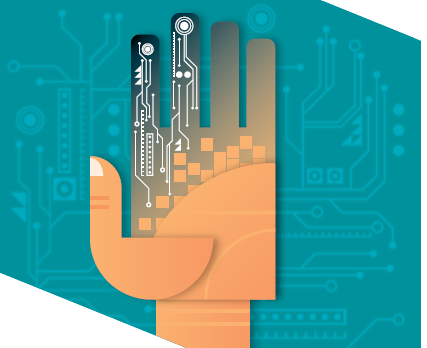The days of innovative, technology-focused start-ups being the only market disrupters and growing faster than their larger, more established competitors may be coming to an end, according to a new report by Accenture, as large enterprises are starting to take advantage of their size, skills and scale to transform into truly digital businesses.
The Accenture Technology Vision 2014 identifies six technology trends that are enabling large enterprises to join those start-ups previously recognized as market disrupters in pushing the boundaries of innovation and taking advantage of digital technologies for competitive advantage. The report finds leading enterprises are pursuing digital strategies that leverage mobility, analytics, and cloud to improve business processes, take advantage of real-time intelligence, expand the boundaries of traditional workforces, and transform the way data is managed and used.
“We’re seeing large enterprises – armed with the resources, scale and drive to reinvent themselves through digital transformation – reasserting leadership in their markets,” said Paul Daugherty, chief technology officer, Accenture. “Leading companies are adopting digital to drive their processes more effectively and transform how they go to market, collaborate with partners, engage with customers, and manage transactions. Digital is rapidly becoming part of the fabric of their operating DNA and they are poised to become the digital power brokers of tomorrow.”
The six IT trends identified as driving the digital power shift are:
Digital-Physical Blur – Extending intelligence to the edge: The real world is coming online as wearable devices, smart objects and machines provide us with real-time intelligence, changing how we live and how businesses operate. This new layer of connected intelligence augments workforce capabilities, automates processes, and incorporates machines into our lives. For consumers, this provides new levels of empowerment, and for organizations, getting real-time, relevant data means both machines and employees can act and react faster and more intelligently in virtually any situation. In healthcare, for example, Koninklijke Philips N.V. is running a pilot Google Glass application that allows physicians wearing the display to simultaneously monitor a patient’s vital signs and react to surgical procedural developments, without needing to turn away from the patient or procedure.
From Workforce to Crowdsource – The rise of the borderless enterprise: Picture a workforce that extends beyond its employees, consisting of any willing individual connected to the Internet. Technology now allows organizations to tap into vast pools of resources around the world, just as companies like MasterCard Incorporated and Facebook Inc. do through organizations such as Kaggle Inc., a global network of computer scientists, mathematicians, and data scientists who compete to solve problems ranging from finding the best airline flights to optimizing retail-store locations. Channelling such efforts to achieve business goals is a challenge, but the opportunity is enormous: tapping an immense, agile workforce that is not only well-suited to solving some of today’s toughest business problems, but also, in many cases, is motivated enough to do it for free.
Data supply chain – Changing the way data is handled to put information into broader circulation: Data technologies are evolving rapidly, but most have been adopted in a piecemeal fashion. As a result, enterprise data is vastly underutilized. Currently, just one in five organizations integrates data across the enterprise. To truly unlock data’s potential value, companies must start treating it more as a supply chain, enabling its easy and useful flow through their entire organizations, and eventually throughout their ecosystems, too. Companies such as Google Inc. and Walgreens Co. have adopted this approach by opening up APIs; more than 800,000 websites now use Google Maps data, and third-party developers are able to include the ability to scan barcodes from Walgreens’ prescription bottles into their apps to make it easier for people to refill prescriptions.
Harnessing Hyperscale – Hardware is back (and never really went away): The hardware world is now a hotbed of innovation as demand soars for bigger and faster data centers. Advances in areas such as power consumption, processers, solid state memory, and infrastructure architectures are giving enterprises new opportunities to massively scale, increase efficiency, drive down costs, and enable their systems to perform at higher levels than ever before. As companies digitize their businesses, more and more will see hardware as essential to enabling their next wave of growth.
Business of Applications – Software as a core competency in the digital world: Mimicking the shift in the consumer world, enterprises are rapidly adopting apps in a push for greater operational agility. According to Accenture research, 54% of the highest-performing IT teams have already deployed enterprise app stores, facilitating this shift towards simple, modular apps for employees. IT leaders and business leaders must establish who plays what role in app development in their new digital organizations, as pressure for change is driven by the business. They must also transform the app development process itself, in order to take advantage of new technologies quickly, support regular software iterations, and, ultimately accelerate business growth.
Architecting Resilience – “Built to survive failure” is the mantra of the non-stop business: In the digital era, businesses are expected to support the non-stop demands placed on their processes, services and systems. This has ripple effects throughout an organization, especially in the CIO’s office where the need for “always on” infrastructure can mean the difference between “business as usual” and the erosion of brand value. Companies such as Netflix, Inc., which uses automated testing tools to deliberately attack its systems as a means to increase resiliency, are among today’s IT leaders. These companies ensure that their systems are designed and built for failure, taking advantage of modular technologies and advanced testing processes rather than designing to specifications.
“These key trends build on those we have seen over the past couple of years,” added Nick Taylor, managing director, ASEAN Technology Lead, Accenture. “Last year, we declared that every business is a digital business, whether its leaders acknowledged that or not. Now, we see that digital technologies run through every facet of the highest-performing businesses. Looking at the shifts in technology and the impact they’re having on the strategies and operational priorities of organizations around the world, we believe there are tremendous opportunities for every C-suite executive to be a digital disruptor – to reinvent and redefine their business to create lasting competitive advantage.”





































































































